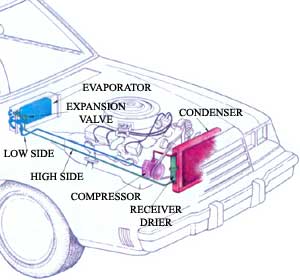These auto air conditioning maintenance tips will help keep your car keep its cool, including how air conditioning works and a trouble-shooter’s guide to automobile air conditioning.
Other than a radio, auto air conditioning is the most popular new-car accessory today. Over 75% of all pride and joys roll out of the showroom with “factory air.” What’s more, each year a half-million used cars have air conditioners added.
Auto Air Conditioning Maintenance Tips
Even though air conditioners are only slightly less common than rear-view mirrors, few car owners have any clear idea just how one works or what to do if it doesn’t. It’s an unknown realm where the normally adventurous amateur mechanic fears to tread. There is some reason for this reluctance. Any air-conditioner problem that involves opening the pressurized system to the atmosphere should probably be left to the pros, who have the expensive tools and expertise needed. But a whole host of common problems fall short of drastic measures and are easily within reach of a shade-tree mechanic. And even if you don’t qualify for that title, and decide to leave the work to others, you’ll be better off if you understand the trouble.
How Does Auto Air Conditioning Work?
It’s very simple: An auto air conditioner — as well as its close kin, the home air conditioner and the refrigerator — moves heat. Refrigerant picks heat up inside the car and carries it outside. Technically termed a vapor-compression cooler, an air conditioner relies on two basic physical principles to capture and release heat:
1. When a liquid changes to a gas (boils), heat is absorbed; when the gas condenses, the same amount of heat is released. The amount of heat needed to vaporize a pound of water, to make the leap from 211 degrees Fahrenheit to 212 degrees Fahrenheit, is 970 Btu (British thermal units). By contrast, it takes only 1 Btu to get from 210 degrees Fahrenheit to 211 degrees Fahrenheit. It’s this change of phase that allows an air conditioner to get so much work out of a small amount of refrigerant.
2. The amount of pressure on a liquid or gas affects both its temperature and also the temperature at which it boils or condenses. For instance, if you apply 20 pounds per square inch (psi) of pressure to 211 degrees Fahrenheit water, it will warm to 257 degrees Fahrenheit and will still be on the verge of boiling. Because temperature and pressure are directly related, jimmying with one or the other as appropriate will allow gases to be changed to liquids (and vice-versa) with comparative ease.
An auto air conditioner moves heat by allowing a liquid to become a gas inside the passenger compartment (thus absorbing heat) and then returning the gas to liquid form outside the passenger compartment (where it gives up heat). The liquid happens to be refrigerant-12 (often called R-12 or Freon, the DuPont trademark). R-12 is used because it happens to have a stable and convenient boiling point (19 degrees Fahrenheit at 20 psi). Otherwise, it really doesn’t have magical properties. In fact, R-12 has a couple of disadvantages compared to its mundane relative, water: When exposed to flame or hot metal, it forms poisonous phosgene gas. Also, the family of chlorofluorohydrocarbons is implicated in the destruction of the earth’s protective layer of stratospheric ozone.

Auto Air Conditioning Maintenance Tips
by
Tags:

Leave a Reply